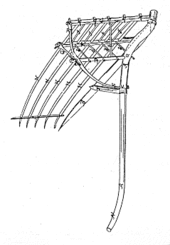- Cradle (grain)
-
A cradle (also called cradle scythe, or grain cradle) is an agricultural tool, a form of the scythe, used to reap grain. It is a scythe with an arrangement of fingers attached to the snath, snathe or snaith (handle), such that the cut grain falls upon the fingers and can be cleanly laid down in a row for collection.
Contents
History
As agriculture (and particularly the cultivation of grain) developed, the end of a season was the harvest. Grain could be pulled or, more typically, cut and the sickle was the usual tool, leaving sheaves of grain to be gathered. The scythe improved the process, because the long handle allows the reaper to work standing up.
Reaping with a scythe before the invention of the cradle readily resulted in the grain forming a muddled carpet on the field, making gathering and transport time-consuming.
In 1794, a Scottish farmer invented "a most marvellous and wonderful machine for cutting grain" [1]. This was the cradle, which revolutionized the harvesting of grains.
The American cradle
 American cradle (patent drawing)
American cradle (patent drawing)
The American-pattern cradle[clarification needed] probably originated between 1800–1840.[2] Users of this tool could harvest significantly increased amounts of grain on a daily basis.[3]
The center of interest in this agricultural tool was the American Midwest, where grain growing was a major industry. United States patents in the decades from 1820 to 1930 totaled 50, the first issued in 1823 to a gentleman in western New York state and the last issued in 1924 to a gentleman in West Virginia. The peak of innovation was in the third quarter of the 19th century [4].
Decline
The cradle was commonly used throughout the 1800s and into the beginning of the 20th century, in part because many of the smaller farms were not designed for mechanical reaping and in part because there were still a great number of smaller farms where the mechanical reaper was not economical. However, by the end of the 19th century the cradle had been generally replaced by the mechanical reaper, a horse-drawn (or tractor-drawn) machine patented by Cyrus McCormick in 1834, and later by other mechanical methods of harvesting such as the combine harvester.
References
- ^ "Dakota Wheat Fields", Harper's New Monthly Magazine Vol LX, published 1879-1880; from the Making of America Project, Harper's Magazine Foundation (New York, N.Y.), Henry Mills Alden, Thomas Bucklin Wells, Lee Foster Hartman , Frederick Lewis Allen; digitized by Google.
- ^ Divine, Robert A.; Breen, T.H.; Fredrickson, George M.; Williams, R. Hal; Gross, Ariela J.; Brands, H.W. & Roberts, Randy (©2007). "Chapter 9: Nation Building and Nationalism". America: Past & Present. Pearson Education, Inc./Longman. p. 174. ISBN 0-536-501-85-8.
- ^ "American Grain Cradles", Richard Van Vleck, http://www.americanartifacts.com/smma/grain/cradle.htm
- ^ "American Grain Cradles" http://www.americanartifacts.com/smma/grain/decade.htm
External links
 Media related to Cradle scythes at Wikimedia CommonsCategories:
Media related to Cradle scythes at Wikimedia CommonsCategories:- Cutting tools
- Mechanical hand tools
- Gardening tools
Wikimedia Foundation. 2010.

